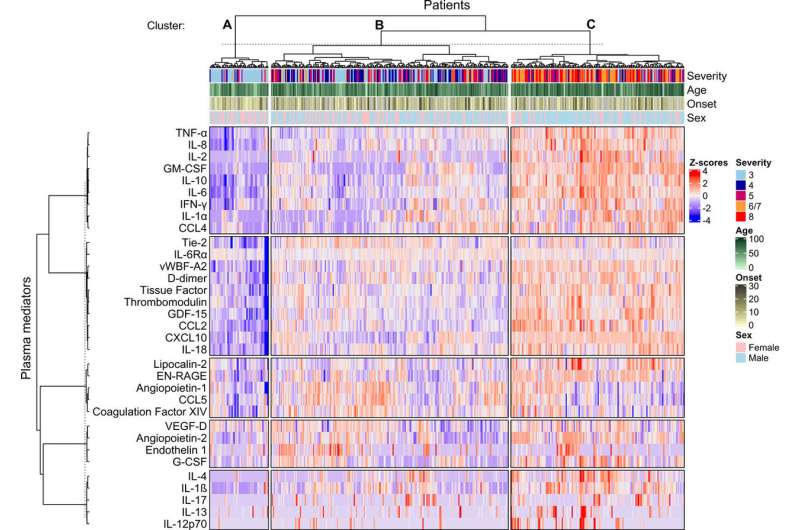Key inflammatory markers identified in COVID-19

A new study involving the University of Liverpool has identified new biomarkers of inflammation that both indicate the severity of COVID-19 and distinguish it from severe influenza.
Led by the UK's International Severe Acute Respiratory and Emerging Infection Consortium (ISARIC) and supported by the UK Coronavirus Immunology Consortium (UK-CIC), the study is the largest of its kind to date.
Published in Science Immunology, the study identifies clusters of inflammatory disease markers (including two called GM-CSF and IL-6) that scale with COVID-19 severity. IL-6 is already proven to be a target for therapies that reduce disease severity in severe COVID-19, but GM-CSF has potential as a new marker of severity that distinguishes COVID-19 from influenza, giving insights into the causes of severe disease and potentially offering a new focus for therapy.
It is important to understand why some patients with COVID-19 experience severe disease, while others recover with less medical support. A 'cytokine storm," where uncontrolled levels of cytokines (proteins released by immune cells) cause excessive inflammation, has been identified as a driver of COVID-19 severity. Anti-inflammatory drugs such as corticosteroids (e.g., dexamethasone) or those that interrupt cytokine function (e.g. tocilizumab) substantially reduce mortality in COVID-19 patients. However studying the underlying inflammatory response in more detail can help researchers to identify new therapies and target healthcare resources to the most at-risk individuals.
Teams of researchers from across the UK, including Imperial College London, University of Edinburgh and University of Liverpool, combined their efforts to demonstrate that only select features of the cytokine response to COVID-19 distinguish the most severe forms of disease. Using the ISARIC4C platform, the researchers recruited 471 hospitalized COVID-19 patients (who were stratified by disease severity) along with 39 outpatients with mild disease. They analyzed 33 disease markers in the blood plasma of these patients.
They found that many inflammatory cytokines were elevated in severe COVID-19 and that levels are generally indicative of disease severity. The investigators identified patterns within the data that are characteristic of the most severe cases of COVID-19; two cytokines in particular, IL-6 (interleukin 6) and GM-CSF (granulocyte-macrophage colony stimulating factor) playing central roles. When compared with archived samples from severe influenza patients, GM-CSF stood out as a specific marker for severe COVID-19. This cytokine can also be detected in early COVID infection, indicating it may play a pathologic role in early disease development in some patients.
While older patients showed a greater all-round inflammatory response, age was not a specific determinant of GM-CSF levels in this study. This suggests that a disease-specific mechanism that exacerbates age-dependent inflammatory responses is likely to operate in COVID-19. There was also no difference found between responses of men and women as has previously been reported in other smaller studies.
The findings from this study could impact patient care and treatment in two ways. First, the study has rationally identified GM-CSF as a key component of the inflammatory response and as a potential therapeutic target. Further research is also needed to see if GM-CSF could be used as a marker in early disease to identify those at risk of going on to develop more severe symptoms.
Dr. Ryan Thwaites, author and Research Associate at Imperial College London, said: "Understanding the underlying mechanism of the immune response in patients who are very ill with COVID-19 is crucial to allowing us to identify potential therapeutic targets. The immune response is incredibly complex but by assessing levels of multiple markers and how they relate to each other, we've been able to increase our knowledge of the immune profile of severely ill COVID-19 patients."
Professor Calum Semple, ISARIC4C lead and Professor of Child Health and Outbreak Medicine at the University of Liverpool, said: "ISARIC's planning for an outbreak just like this has enabled timely discoveries that are informing case management and driving therapeutic developments. Also deserving recognition are the NIHR clinical research staff at all our NHS hospitals and the university staff that support the outbreak laboratories in Glasgow and Liverpool who together collated the data and samples that enabled these discoveries."
More information: Ryan S Thwaites et al. Inflammatory profiles across the spectrum of disease reveal a distinct role for GM-CSF in severe COVID-19, Science Immunology (2021). DOI: 10.1126/sciimmunol.abg9873



















